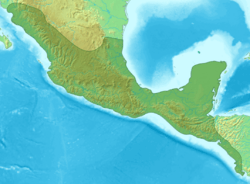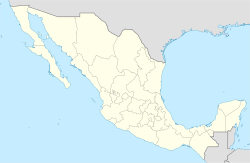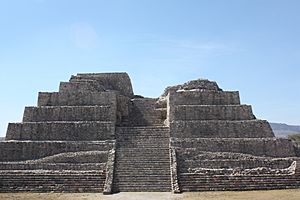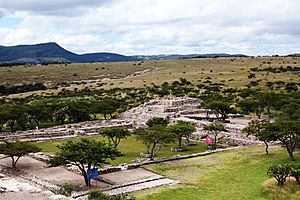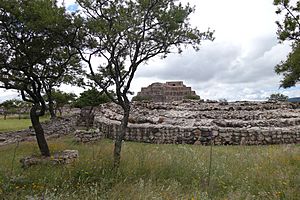Cañada de la Virgen facts for kids
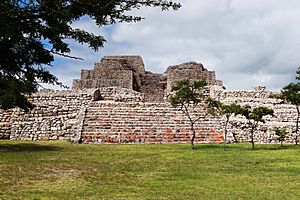
Complex A, the House of the Thirteen Heavens
|
|
| Location | San Miguel de Allende, Guanajuato, Mexico |
|---|---|
| Region | Bajío |
| Coordinates | 20°51′29″N 100°55′42″W / 20.85806°N 100.92833°W |
| History | |
| Founded | 540 AD |
| Abandoned | 1040 AD |
| Periods | Late Classic to Early Postclassic |
| Cultures | Otomí |
| Site notes | |
| Archaeologists | Gabriela Zepeda García Moreno, Rossana Quiroz Ennis, Francisco Granados |
Cañada de la Virgen is an ancient Otomi city in Mexico. Its name means "Virgin's Glen" in Spanish. This amazing archaeological site is found in the state of Guanajuato.
Archaeologists first started exploring the site in 1995. Official digs began in 2002. People were first allowed to visit Cañada de la Virgen in 2011. Unlike other famous sites like Chichen-Itzá, visits here are carefully managed. This is because the site is on private land.
The Otomi people have lived in the San Miguel de Allende valley for thousands of years. It is thought that building at Cañada de la Virgen started around 530 AD. This was after the Teotihuacan culture ended. The Otomi were great sky watchers. They passed down knowledge about the stars and planets. They chose this spot to build a special burial site. They used their knowledge of the stars, their beliefs, and farming cycles. The site faces north, towards where the stars seem to spin. The moon also lines up with the pyramids at important times.
This site was important for studying the Moon, Sun, and Venus. Scientists from the National Institute of Anthropology and History (INAH) have studied this. Key parts of the site include the Ceremonial Avenue, House of the Wind, House of the Longest Night, and House of the Thirteen Heavens. The Otomi believed in a balance between heaven and earth, like the Sun and Moon.
Around 900 AD, the Otomi civilization began to weaken. By 1050 AD, the site was left empty. It was only found again at the end of the 20th century. Work and research are still happening there today.
Contents
Exploring the Ancient City
At Cañada de la Virgen, you can see seven huge pyramid-like buildings. They are all different sizes and styles. These structures form sunken courtyards, open squares, and even a ball game court. There is also a road about 1-kilometre-long (0.62 mi). Scientists have found old pottery here. This suggests that the last people to live here were linked to the Toltec culture.
This ancient settlement was on the northern edge of Mesoamerica. Its main buildings were used to watch the sky. The city's layout shows how it was connected to the sky's cycles. These cycles were important for farmers and hunter-gatherers. They also traded goods with other Mesoamerican regions.
The buildings here are like other Mesoamerican structures. They are often lined up with where the Sun and Moon rise and set. This site also had a great view of the Laja River basin. This made it a very important place for special events and ceremonies.
The buildings were closely linked to the stars. This is clear in Complex A, also called the House of the Thirteen Heavens. This was a key place for watching the sky. Its sunken courtyard may have held water. Priests could then look at the sky's reflection. This helped them understand the farming year.
The buildings are on a flat area. This area was built up to have a special 18-degree slope. This allowed the ancient Otomi to track the Sun's path. It helped them mark important dates for farming, like planting and harvesting.
A Look at History
The Toltec and Chichimec people built villages and pyramids. They did this all along the central Laja River basin. This area was known as San Miguel in the 1500s. About a thousand years ago, it might have been called Pánuco.
An old book called the Toltec–Chichimec Codex lists different areas of the Toltec Empire. Cañada de la Virgen would have been in the northwest part of their land. The name of its main city is not known. But it seems to have been a few kilometers south of Cañada de la Virgen. That city had pyramids and a large plaza.
Archaeologists found remains of ovens in the northeast area. This shows that the people here could use limestone. The seven large buildings at the site are step pyramids. They have sloped sides and form different spaces. These include sunken patios, squares, and a long road.
When People Lived Here
Old pottery found on the surface suggests that the last people here were linked to the Toltec expansion.
The history of this area starts with the Chupícuaro culture. This was a very important group in Mesoamerica. They were known for their advanced pottery. They also had complex religious ideas. This shows they had a strong group in power early on. The Chupícuaro lived along rivers. Their culture spread across much of Guanajuato. The Chupícuaro culture ended around 350 AD. Then, another group of advanced farmers appeared.
This next period is called the Sunken Patio tradition. It lasted from about 350 to 900 AD. This time is known for new building styles, like sunken courtyards. These were built with tall pyramids. This was a time of advanced farming. The farming areas also spread further north.
During this time, Guanajuato developed organized centers. These centers had specialized workers. Scientists believe that Toltec groups arrived in the Basin of Mexico between 900 and 1000 AD. This was not when the city of Tula collapsed, which was around 1200 AD.
Around 1350 AD, farming in this area became harder. The land then became home to different Chichimec tribes. These included the Guachichiles, Guamare, and Otomi. At that time, the Lerma River was the border. It separated groups who moved around from those who stayed in one place. Cañada de la Virgen developed during this period.
Amazing Architecture
Cañada de la Virgen has many buildings that are closely connected. Complex A, or the House of the Thirteen Heavens, is very special. It was a key place for watching the sky. It has a sunken patio and a pyramid base over 15 meters tall. There are also platforms that close off the east, north, and south sides.
Archaeologists found human remains in this complex. Studies have shown how people were buried. They also learned about ancient rituals. At the top of Complex A is the Red Temple. It has a simple mural with red and black stripes. These stripes represent day and night.
Complex B, or the "House of the Longest Night," is also in the central area. It has several structures, including a pyramid base and a sunken patio. These parts had different uses. For example, the pyramid base is not perfectly even. It has a room on its south side. This type of building is rare. It is found only in the Maya area and at Cañada de la Virgen. During digs here, archaeologists found a hidden structure. It was used for public events and rituals.
Different Structures
The site has five main groups of monuments. The most important is Complex A. This includes its side buildings, temple base, enclosed patio, main plaza, south plaza, and a road.
During the excavations, many important items were found. These included pots, metal objects, seeds, and human remains.
The main square is on the west side of the site. It contains Basements A and B, which are the most important. Basement A is the largest and most complex. It has a step pyramid, stairways, an upper temple, patios, a plaza, and an avenue.
Complex A
The largest pyramid base is in the center. Other structures spread out from it. This forms different squares and plazas.
The pyramid base has six levels. Remains of a building are at the top. The design of the patio and plaza shows how skilled the Toltec-Chichimec builders were. The top building was split into two parts by a central staircase. This is similar to later Aztec buildings. It was built with stone walls. These walls were covered with mud and stucco (a mix of lime and sand). They were painted red and then ochre. Sadly, part of the building was damaged in the 1940s.
Complex B
Complex B is similar to Complex A, but with some differences. Here, the top building is a bit to the south. It is not centered with the plaza. To the west, there is a slightly raised plaza. This is part of the main square. There might have been another road here. It would have started at the south side of the basement. It would have led to another part of the ravine around the site. In this structure, archaeologists found a stone sculpture of a human. It was the head and left foot of a person from the northern center of Mesoamerica.
Complex C
As of 2017, this complex has not yet been dug up.
Complex D
This is the north basement. It has very special features. The bottom part is rectangular, but the top parts are circular. This mix is very rare in this region.
Complex E
This structure is to the south of the complex. It is a step pyramid base. It forms an open patio to the south. This is different from the other patios, which are closed on all four sides. A piece of stonework was found here. It might have been part of a decorated band or doorframe.
Protecting the Site
The main basement of Complex A was damaged over time. Large holes appeared at the bottom. Because of this, some repairs were made in 1989. This was done to stop the southwest corner from falling apart. It also helped keep the upper parts stable.
Visiting Cañada de la Virgen
The archaeological site opened to the public on February 15, 2011. You can visit from Tuesday to Sunday, from 9 am to 3 pm. If you need a ride or a guide, many tour companies in San Miguel de Allende can help.
This site is very well protected. There are some rules for visitors. There is a Visitor Center with parking and a museum. The museum opened in 2017. You can only get to the site by a special shuttle bus. The walk from where the bus drops you off is about 3 km round trip. Visitors must have an escort. This person makes sure you get back to your bus on time. The whole trip from the Visitor Center takes about 2.5 hours.
No large bags, backpacks, or purses are allowed into the site. This is to prevent theft of old artifacts. Small camera bags, cameras, and water are allowed. If you have trouble walking, the tour might be difficult.
Images for kids
See also
 In Spanish: Cañada de la Virgen para niños
In Spanish: Cañada de la Virgen para niños


